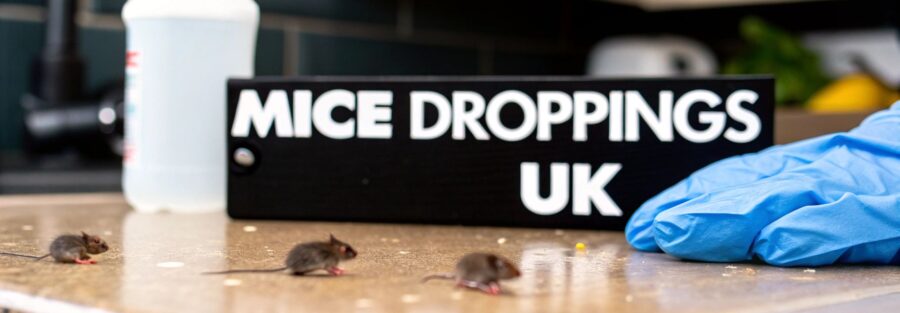Finding little dark pellets scattered around your home is one of the surest signs you’ve got unwanted house guests. Mice droppings in the UK are typically small (3-6mm), black, and look like grains of rice with pointed ends. Being able to spot them is the first, most important step towards dealing with an infestation and getting your home back.
How to Confidently Identify Mice Droppings in Your Home
Finding mysterious droppings can be a bit grim, but learning to identify them is a skill every homeowner should have. Think of it as a bit of detective work; the clues they leave behind tell you exactly what sort of pest you're dealing with. This knowledge lets you take the right next steps, whether that’s putting down some traps or calling in a professional.
Getting it right from the start saves you a world of time, money, and stress. After all, the way you’d handle a mouse problem is completely different from how you’d tackle a rat infestation.
What to Look For: Size, Shape, and Texture
When you come across potential mice droppings, UK residents should keep an eye out for a few key features. They’re tiny, usually no bigger than a quarter of an inch (around 3-6 mm). Their shape is the main giveaway—they aren't round but are more spindle-shaped, like a minuscule grain of rice with pointy tips.
The texture and colour also tell a story about how long the infestation has been going on.
- Fresh Droppings: These are dark black, soft, and have a putty-like feel. Their shiny, damp look means a mouse has been nearby very recently, probably within the last 24 hours.
- Old Droppings: After a few days, the droppings dry out. They become hard and brittle, crumbling into a fine dust if crushed (which you should never do without wearing protective gear). Their colour also fades to a dull, greyish-brown.
If you find a lot of droppings in one area, ranging from fresh and dark to old and grey, it’s a strong sign you’re dealing with an active, established infestation—not just a one-off visitor. This is a clear signal that the problem needs sorting out sharpish.
Mouse Droppings vs Rat Droppings: A Critical Distinction
It's vital not to mistake mouse droppings for rat droppings, as they point to a very different scale of problem. While a mouse dropping is about the size of a grain of rice, a rat dropping is much chunkier, often looking more like an olive stone or a bean. For a more detailed comparison, our guide on rat droppings size can help you tell the difference with confidence.
Knowing what to look for makes identification much easier. The pest you have dictates the treatment plan, so getting this right is key.
Mouse Droppings vs Rat Droppings: A Quick UK Comparison
| Characteristic | Mouse Droppings | Rat Droppings (Brown Rat) |
|---|---|---|
| Size | Small, 3-6 mm long | Large, 12-20 mm long |
| Shape | Spindle-shaped with pointed ends | Blunt, sausage or capsule-shaped |
| Quantity | Numerous (50-80 per day) in scattered groups | Fewer (20-50 per day) in concentrated areas |
| Appearance | Similar to a grain of rice | Similar to a bean or olive stone |
This quick check should help you figure out what you’re up against and decide on the best course of action.
Common Hotspots: Where to Look for Evidence
Mice are creatures of habit. They tend to stick to the same routes, usually scurrying along walls and through secluded, quiet spots. When you're on the hunt for droppings, focus on these common hotspots where they feel safe enough to feed, nest, and travel.
- Kitchen Areas: Have a look behind or under appliances like the fridge, oven, and dishwasher. Check inside cupboards—especially where you store food—and along the back of your worktops.
- Utility and Storage Rooms: Lofts, basements, and airing cupboards are prime real estate for nests. Inspect along skirting boards, in corners, and inside any old boxes you have stored away.
- Under Sinks: The little gaps where pipes come through the walls are classic entry points. This makes the cupboards under kitchen and bathroom sinks a common place to find evidence.
- Hidden Voids: Don’t forget to check inside suspended ceilings, behind bath panels, and in any other dark, hidden spaces that offer shelter.
By checking these areas methodically, you’ll quickly get a clear picture of where the problem is and how serious it might be.
Understanding the Health Risks of Rodent Droppings
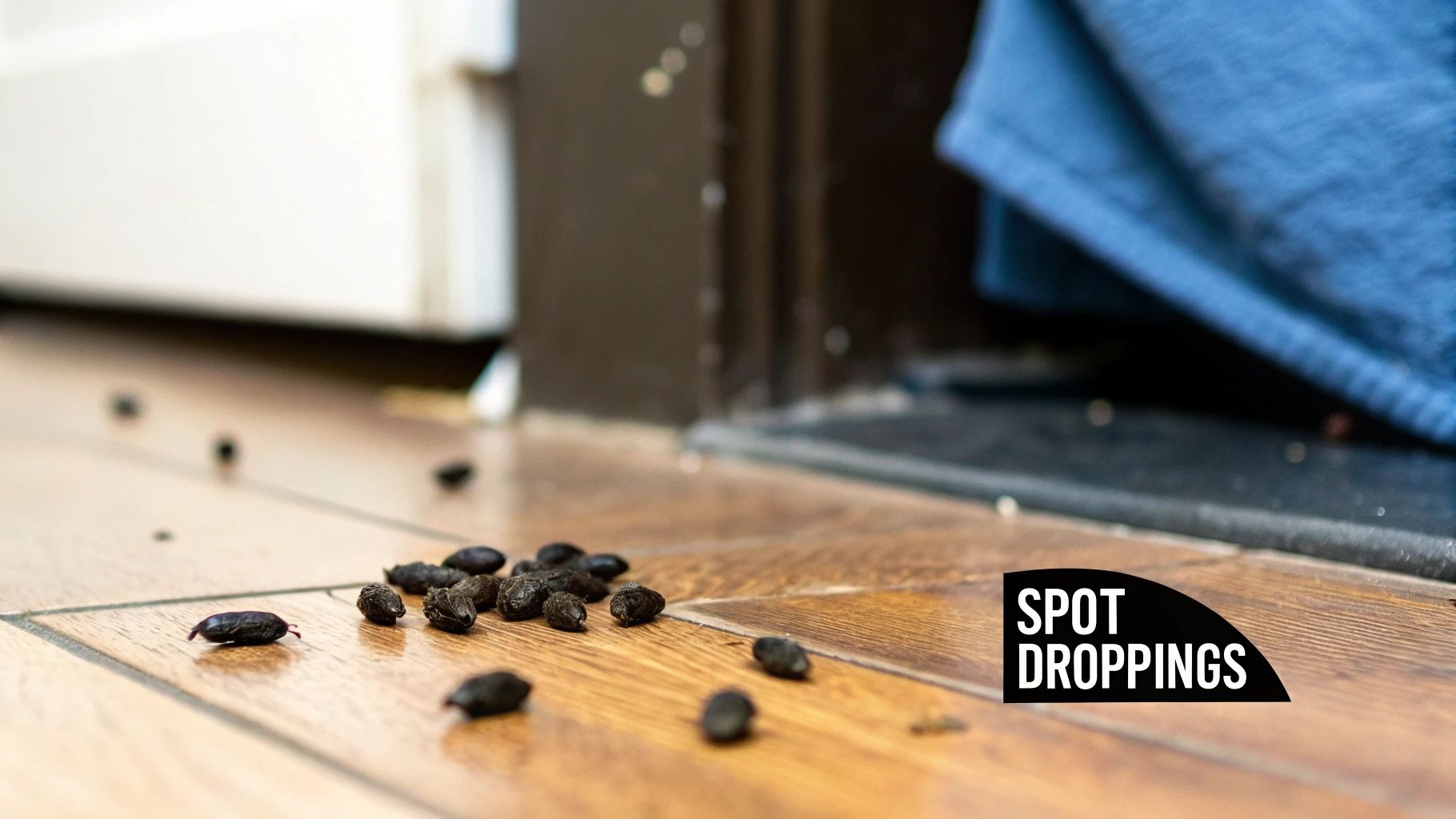
Finding mice droppings is more than just an unpleasant clean-up job; it’s a clear warning sign of a potential health hazard in your home. While nobody wants to see them, the real danger is what you can't see—the invisible germs and viruses these droppings can harbour. Knowing the risks is the first step to protecting your family and understanding why a careful, methodical approach to cleaning is so important.
The main danger doesn't always come from direct contact, although that’s certainly a risk. The most significant threat is often airborne.
When old droppings, urine spots, or nesting materials are disturbed—even by something as simple as sweeping them up—dangerous particles can be kicked up into the air. Breathing in this contaminated dust is one of the easiest ways to get seriously ill.
The Hidden Dangers UK Homes Face
Mice in the UK, just like anywhere else, can carry a range of diseases that pass to humans. Their droppings essentially act as tiny delivery vehicles for pathogens, bringing them straight from the outside world into your kitchen cupboards, loft, and living areas.
Here are a few of the key health risks that mice droppings in UK homes can pose:
- Salmonellosis: This is a nasty bacterial infection that leads to diarrhoea, fever, and stomach cramps. It’s usually picked up by handling contaminated materials and then touching your mouth, or by eating food that mice have walked over or nibbled on.
- Leptospirosis: Caused by the Leptospira bacteria, this illness can feel like a bad flu but can escalate to kidney failure or meningitis. The bacteria live in mouse urine and can get into your system through small cuts or via your eyes, nose, or mouth.
- Hantavirus: While less common in the UK, Hantaviruses are a serious global concern. They can cause Hantavirus Pulmonary Syndrome (HPS), a severe and sometimes fatal respiratory illness. It’s almost always transmitted by inhaling dust contaminated with rodent droppings, urine, or saliva.
Don't underestimate the scale of the problem. Local authorities in the UK recently made 291,132 visits to homes for pest problems, and a staggering 91% of them were for rodents. That works out to a visit every two minutes, underlining just how widespread this issue is. You can explore the full report on UK pest interventions to learn more about this growing concern.
Why Vulnerable Family Members Are at Greater Risk
Anyone can get sick from exposure to mice droppings, but for some people, the risk of serious complications is much higher. Their immune systems simply aren't as strong, making it harder to fend off infections.
It's crucial to realise that the presence of mice elevates the health risk for everyone in the household, but especially for those who are most vulnerable. A minor infestation for a healthy adult could pose a serious threat to a child or an elderly relative.
This heightened risk is particularly true for:
- Young Children: Their immune systems are still developing. Plus, they spend a lot of time playing on the floor and have a habit of putting their hands in their mouths, which increases exposure.
- The Elderly: As we get older, our immune response naturally weakens, making seniors more susceptible to severe illness from bacterial or viral infections.
- Individuals with Compromised Immune Systems: Anyone with a condition like asthma, HIV, or who is undergoing chemotherapy has a much lower ability to fight off germs, making any exposure a serious danger.
- Pregnant Women: Some infections carried by rodents can cause serious complications during pregnancy, affecting both the mother and her unborn baby.
When you understand these risks, the clean-up job stops being a simple chore and becomes a critical health and safety procedure. This isn't just about tidying up; it's about actively removing a source of potential illness from your home.
Your Step-by-Step Guide to Safely Cleaning Up Mice Droppings
So, you’ve found what you’re pretty sure are mice droppings. The first instinct for many people is to grab a dustpan and brush or the hoover. Stop right there. That’s probably the most dangerous mistake you can make.
When you sweep or vacuum dry droppings, you’re sending microscopic, virus-carrying particles airborne. Inhaling this contaminated dust is how diseases spread.
Instead, the only safe way forward is what we call the 'wet-cleaning' method. It’s a simple technique that neutralises any nasty pathogens before you even start cleaning, massively cutting down the risk to you and your family. A few extra minutes here is a non-negotiable part of getting the job done right.
This infographic shows exactly how easily pathogens can become airborne when droppings are disturbed.
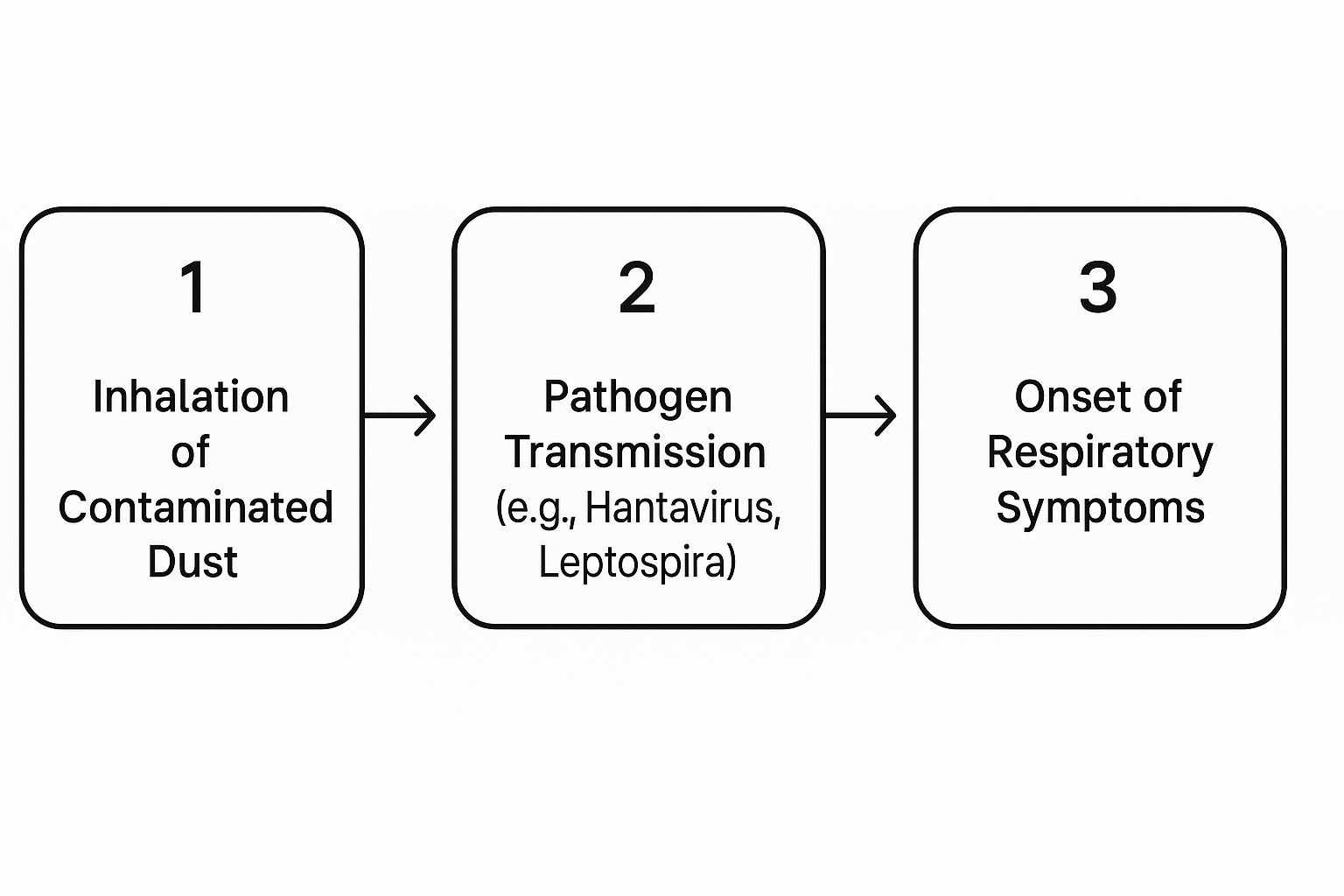
As you can see, it all starts with breathing in contaminated dust, which is a direct route for germs to enter your system and cause some pretty unpleasant respiratory symptoms.
Preparing for a Safe Cleanup
Before you touch a single thing, you need to get your kit together. Think of this as creating a solid barrier between you and any potential hazards. The goal is simple: no direct contact with the droppings and no spreading germs to other parts of your house.
Here’s your essential clean-up kit:
- Protective Gloves: Go for non-absorbent rubber gloves or a sturdy pair of disposable ones.
- Respiratory Mask: This is crucial. You need a proper mask, ideally FFP2 or FFP3 rated, to filter out airborne particles. A flimsy paper dust mask just won't cut it.
- Disinfectant Solution: A standard household disinfectant containing bleach will do the job, as will a dedicated virucidal cleaner. A homemade solution of one part bleach to ten parts water works perfectly well.
- Paper Towels: Plenty of disposable paper towels are a must.
- Plastic Bags: You'll need a sealable plastic bag to safely bin all the contaminated waste afterwards.
Making sure you're protected is the top priority. To learn more about the correct use of Personal Protective Equipment (PPE), it’s worth a quick read to keep yourself fully protected.
The Step-by-Step Wet-Cleaning Method
Right, you’ve got your gear ready. Now it’s time to follow the process carefully. Don’t rush these steps—every single one is there for a reason and is designed to minimise risk and properly decontaminate the area.
Step 1: Ventilate the Area
First things first, open any windows and doors nearby for at least 30 minutes before you start. This gets fresh air moving through the space and helps disperse any contaminated dust that might already be hanging in the air. Never, ever start cleaning in a stuffy, unventilated room.
Step 2: Soak the Droppings
Get your gloves and mask on. Now, generously spray your disinfectant solution directly onto the mice droppings and any surrounding urine stains or tracks. Let it sit and soak for at least five minutes. This is the most important step, as it kills the pathogens on contact and makes the droppings safe to handle.
Never sweep or vacuum droppings before soaking them. The action of a brush or the powerful suction of a vacuum is brilliant at launching hazardous dust straight into the air you’re breathing. Soaking them first completely eliminates this risk.
Step 3: Wipe and Remove
Using your paper towels, carefully wipe up the soaked droppings and any leftover disinfectant. Pop the used paper towels straight into your plastic bag. Don't be tempted to use a reusable cloth, as you'll just end up spreading the contamination around.
Step 4: Disinfect the Entire Area
Just because the visible droppings are gone doesn't mean the job is done. Now you need to disinfect the whole area. Mop the floors and wipe down any worktops, shelves, or other surfaces that the mice might have scurried across, using your disinfectant solution.
Step 5: Securely Dispose of All Materials
Put everything you used for the clean-up—paper towels and your gloves included—into the plastic bag. Seal it tightly, then pop that bag inside another one (this is called double-bagging). Get it straight into an outdoor rubbish bin.
Step 6: Wash Your Hands Thoroughly
Finally, once your protective gear is off and the rubbish is out, give your hands a proper wash with soap and warm water. If you’re not near a sink, an alcohol-based hand sanitiser is a good temporary fix. Follow this process, and you can be confident you’ve dealt with the health hazard safely and effectively.
Effective Prevention Strategies to Keep Your Home Mouse-Free
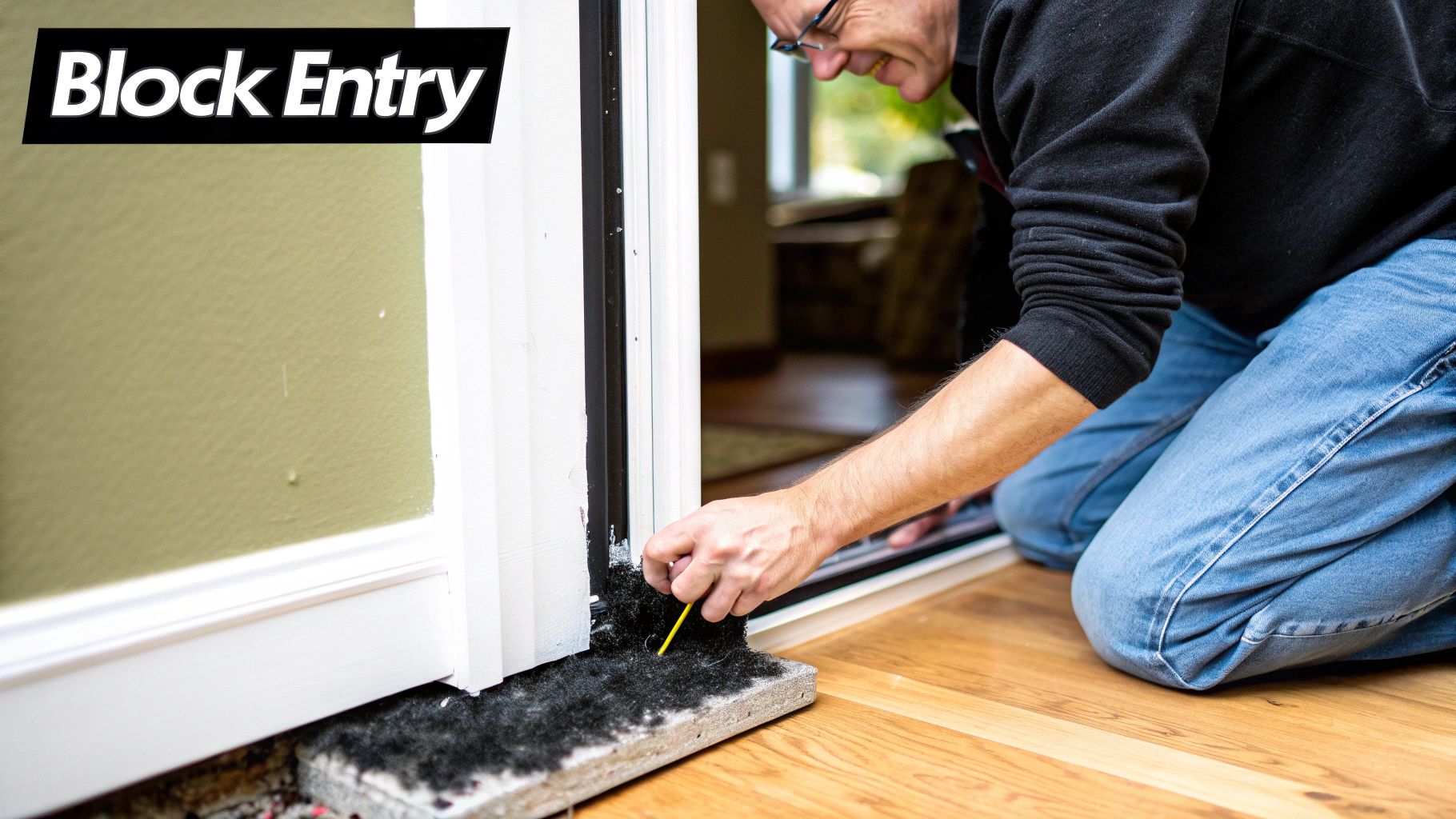
Safely cleaning up mice droppings is a massive relief, but it’s only half the battle. You've treated the symptom, but the real victory comes from making sure they never get back in.
True, long-term pest prevention is about turning your home from an easy target into a fortress that mice simply can’t breach. It’s a proactive game plan built on three powerful, common-sense pillars. By focusing on these, you can secure your home and avoid the stress of another infestation down the line.
Sealing Every Possible Entry Point
First things first: you have to block their way in. A mouse can squeeze through a gap the size of a pencil (around 6-7 mm), so you need to start thinking like they do—small. A thorough inspection of your home's exterior and interior is the only way to spot these weak points before they do.
Imagine you're a mouse looking for warmth and food. Where would you try to get in? Start by methodically checking the perimeter of your property, paying close attention to where pipes and cables enter the house.
Common entry points to inspect and seal include:
- Pipe and Cable Gaps: Look for tiny spaces around water pipes, gas lines, and electrical cables where they pass through walls.
- Air Bricks and Vents: Old or damaged air bricks are basically an open invitation. Cover them with fine wire mesh that lets air flow but keeps pests out.
- Gaps in Foundations: Check for cracks in the brickwork or gaps under doors, especially garage doors.
- Roofline and Eaves: Don't forget to look up. Mice are fantastic climbers, so inspect for gaps where the walls meet the roof.
For a deeper dive into their tactics, our guide explains how mice get into your house and reveals all their sneaky tricks. When sealing gaps, use materials mice can't chew through, like wire wool stuffed into small holes and sealed with caulk, or cement for larger cracks.
Removing Their Food and Water Sources
A mouse simply won't stick around if there's nothing to eat. Your kitchen is their number one target, so making it an unattractive place is key to your defence. This goes beyond just wiping up spills; it’s about fundamentally changing how you store food.
A few crumbs left on a worktop or a bag of pasta that isn't properly sealed is an all-you-can-eat buffet for a mouse. Cut off their food supply, and you make your home a far less desirable place to live.
It's a simple strategy, but it works wonders.
Here are some practical things you can do right away:
- Airtight Containers: Get all your dry goods like cereal, pasta, flour, and pet food out of their original packaging and into sealed glass, metal, or hard plastic containers.
- Daily Crumb Patrol: Wipe down kitchen worktops, sweep floors, and hoover under appliances every single day. Even the smallest crumbs are a meal for a mouse.
- Secure Pet Food: Don't leave pet food bowls out overnight. Store any unused pet food in a sealed container, just like your own.
- Fix Leaks: Mice need water, too. A dripping tap or a leaky pipe under the sink is a reliable drinking fountain for them, so get it repaired.
Managing Your Rubbish and Garden Waste
Your home’s defences don’t stop at the front door. The area immediately surrounding your property can either attract pests or deter them. Poorly managed rubbish and garden waste create the perfect habitat for rodents, giving them a safe base from which to plan their invasion.
Think of your outdoor bins and garden as a welcome mat. If they're overflowing or cluttered, you're practically inviting pests to come and stay.
To make your property less appealing, focus on these final steps:
- Secure Your Bins: Make sure all your outdoor rubbish bins have tight-fitting lids. If a lid is broken, get it replaced. It also helps to position the bins away from the house if you can.
- Clear Garden Clutter: Get rid of piles of wood, old furniture, or overgrown bushes near your home. These all provide excellent hiding spots and nesting materials for mice.
- Manage Compost Bins: Keep compost bins well-maintained and properly sealed. Crucially, avoid adding cooked food scraps that will attract rodents from miles around.
By systematically tackling these three areas—entry points, food sources, and outdoor waste—you create layers of protection that make your home a no-go zone for mice. This is how you win the long-term war, not just the occasional battle.
When to Call a Professional UK Pest Control Service
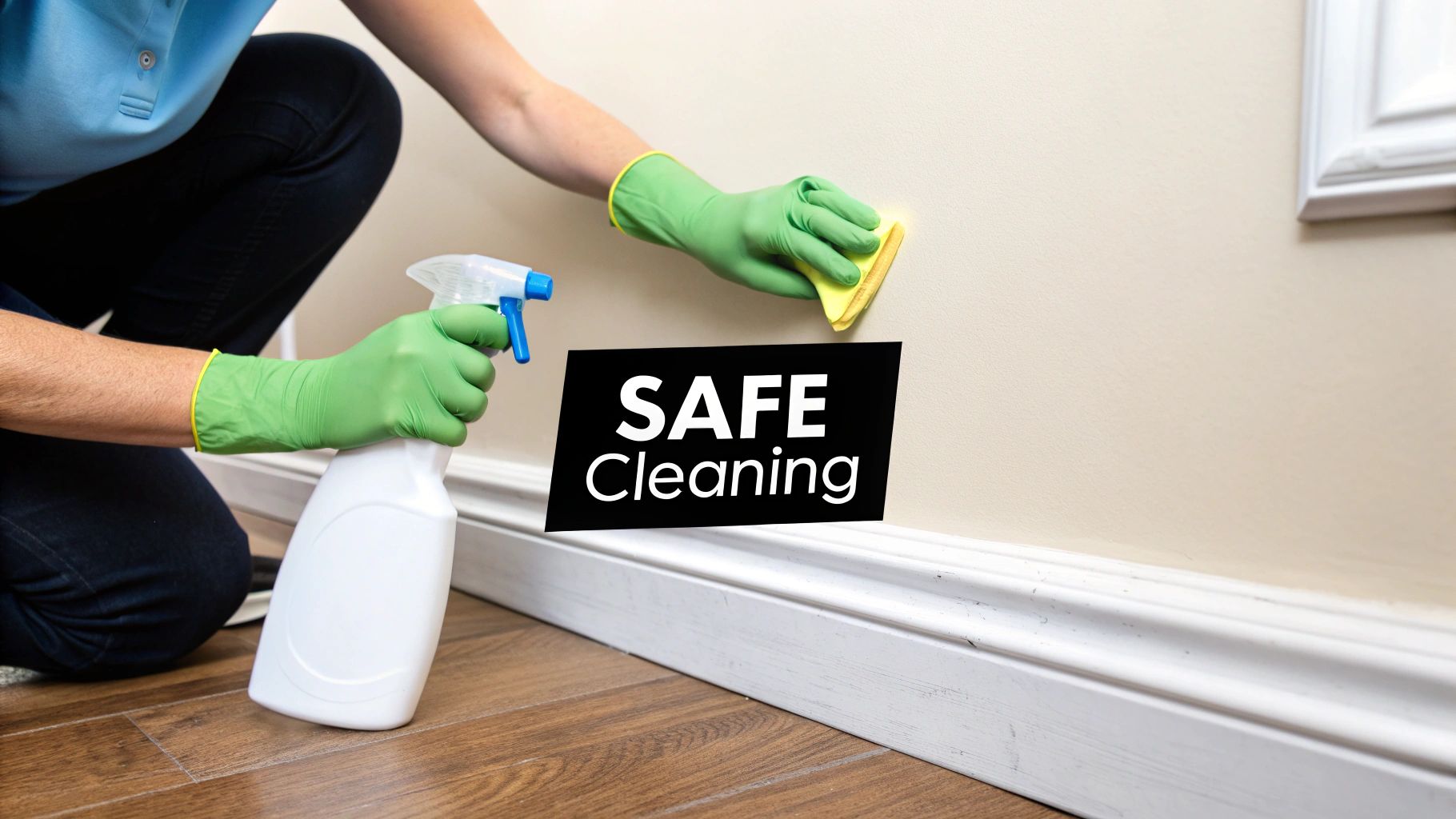
While DIY methods might handle a one-off mouse sighting, there’s a clear line between a minor issue and a full-blown infestation that needs an expert. Knowing when to put down the traps and pick up the phone is crucial for your family's health and your home's integrity.
A few droppings in one corner might feel manageable. But certain signs are unmistakable warnings that the problem has grown far beyond a simple fix. Recognising these red flags means you can act fast, stopping a small problem from turning into a costly and dangerous situation. Ignoring them is a recipe for property damage, increased health risks, and a much tougher battle down the road.
Definitive Signs Your Mouse Problem Is Out of Control
If you spot any of the following, it’s time to stop thinking about DIY solutions and call in the professionals. These aren't just minor clues; they're solid proof that the mouse population in your home is well-established and growing.
- Daylight Sightings: Mice are nocturnal. Seeing one scurrying around during the day is a massive red flag. It often means the nest is so overcrowded that younger, bolder mice are being forced out to find food.
- Persistent Scratching Noises: That faint scratching, gnawing, or scurrying you hear from inside your walls, ceilings, or under the floorboards at night? It’s a classic sign of an active infestation.
- Widespread Droppings: Finding mice droppings in multiple places—like the kitchen, the loft, and behind furniture—shows they've set up travel routes all through your home.
- Visible Gnaw Marks: Discovering chewed wires, damaged furniture, or nibbled food packaging is clear evidence of destructive activity that needs to be sorted out immediately.
- A Strong, Musky Odour: A stale, ammonia-like smell you can't trace is often caused by a large build-up of mouse urine. It points to a significant, hidden infestation.
Mice are a major issue across the UK. The British Pest Control Association (BPCA) reports that pest controllers get around 80,000 callouts for mice each year. This problem shot up during the COVID-19 pandemic, with residential rodent activity increasing by about 50%.
The Value of a Certified UK Pest Controller
Calling a professional isn't just about getting rid of the mice you see; it's about ending the entire problem at its source. Certified technicians bring an expertise, equipment, and strategic approach that DIY methods just can't match.
Think of it like this: a DIY approach is like putting a plaster on a wound. A professional provides the diagnosis and the surgery needed to fix the underlying issue for good. They don't just treat the symptoms; they cure the cause.
When shop-bought solutions aren't cutting it, it’s crucial to understand your options. For more details on professional mice removal services, you can find great information from our partners at Go Assist.
What Professionals Offer That DIY Kits Don't
A professional service is a complete solution, going far beyond just setting a few traps. They have the training to see the full scope of an infestation and put a safe, effective, and lasting plan in place.
Here’s what you get when you hire a certified expert:
- Expert Inspection: A technician can identify all entry points—even the tiny, hidden ones you’d miss—and pinpoint nesting sites with absolute precision.
- Professional-Grade Treatments: They have access to powerful rodenticides and advanced trapping systems that are far more effective and safer for homes with children and pets when used correctly.
- Long-Term Proofing: Beyond just removal, professionals offer robust proofing services. They use durable materials to seal up entry points and stop future infestations before they start.
- Peace of Mind: Knowing the job is done right by a qualified expert is invaluable. For a full breakdown of what’s involved, check out our expert pest control services to see how we handle these situations.
Got More Questions About Mice Droppings?
Even with a plan in place, it’s natural to have a few more questions rattling around. Getting straight, simple answers is the best way to feel confident you’re handling things correctly. Let's tackle some of the most common queries we get from homeowners across the UK.
Think of this as your quick-reference guide for those nagging worries. Knowing these details will help you size up the risks properly and act with total certainty.
How Long Do Mice Droppings Remain a Health Hazard?
This is a crucial question, and the answer is usually longer than people expect. Even after they’ve completely dried out, mice droppings can still be dangerous. Pathogens like certain viruses can stay active and infectious for several days, especially in stable indoor conditions.
Old, crumbly droppings might look harmless, but they can easily break apart into a fine dust. If that dust gets kicked up into the air, you’ve got a serious inhalation risk.
The bottom line is this: always treat any droppings you find—old or new—as potentially infectious. There’s no safe "expiry date" for the health risks they pose. That’s why following the wet-cleaning method with the right protective gear is non-negotiable, every single time.
Can I Get Sick from Just a Few Mouse Droppings?
While the odds are certainly lower with one or two droppings compared to a full-blown infestation, it is technically possible to get sick. The real danger isn’t just about touching them; it's about what happens if that single dropping gets disturbed and its particles go airborne.
You have no way of knowing if that particular dropping is carrying nasty bacteria or a virus. Since the potential for illness is always there, the only sensible approach is to treat every discovery with the same level of caution. A single dropping is more than enough evidence to warrant a full, safe cleanup.
Do Strong Smells Like Peppermint or Bleach Get Rid of Mice?
You’ll see plenty of home remedies suggesting strong scents like peppermint oil, ammonia, or bleach as a deterrent. And it's true, mice have a very sensitive sense of smell and might avoid a powerfully scented area for a little while. But this is not a long-term solution. It’s like putting up a temporary "road closed" sign on a motorway; the traffic will just find another way around.
Mice rely heavily on scent trails from their urine and droppings to navigate. A strong odour might mask these trails for a short time, but it does absolutely nothing to get rid of them.
- Temporary Fix: The smell may confuse mice for a bit or make an area seem less appealing.
- Not a Real Solution: It won’t convince an established colony to pack up and leave.
- Scent Trails Remain: The underlying chemical "road signs" that attract other mice are still there.
The only way to permanently neutralise these scent trails is through proper cleaning and disinfection, which chemically breaks down the pheromones and removes the welcome mat for other pests.
Are Field Mice Droppings Different from House Mice Droppings?
In the UK, you’re most likely dealing with either the House Mouse (Mus musculus) or the Field Mouse, also known as the Wood Mouse (Apodemus sylvaticus). To the naked eye, their droppings look pretty much identical—small, dark, and spindle-shaped. Honestly, trying to tell them apart isn’t a good use of your time.
More importantly, from a health and safety standpoint, there is no difference at all. Both species can carry and transmit diseases harmful to humans. You should treat any small, rod-shaped droppings you find with the same high level of caution, no matter which mouse you think is responsible. The safe cleanup protocol is exactly the same.
If you're facing a persistent rodent problem and need a solution that lasts, Pest Predators Limited is here to help. We combine biological expertise with practical proofing skills to not only remove the current infestation but to secure your home against future invasions. Contact us today to safeguard your property and peace of mind.

